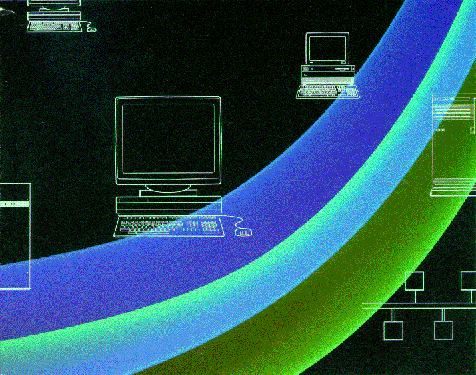|
 Jane C. Blake,
Jane C. Blake,
Managing Editor
Digital's fiber distributed data interface, FDDI, is a high-speed LAN that links workstations, systems,
and other local area networks such as Ethernet. This new LAN offers distance as well as speed, and extends
connections beyond the limits of a building to cover wider areas such as a campus. Papers in this issue of
the Digital Technical Journal provide insights into the technology choices made during FDDI development and describe
the design of the layers and products that make up this 100-megabit/second LAN system.
Among the reasons Digital's engineers chose FDDI technology were its high speed, high throughput, and consistency
with existing and evolving standards. In this issue's opening paper, Bill Hawe, Rich Graham, and Peter Hayden
review these selection criteria and discuss the reasoning behind the final choices. The authors
additionally present an overview of FDDI layers and product operations, which establishes a context for the
papers that follow.
The lowest FDDI layer provides the physical connections for data transmission on the fiber-optic ring. In their paper,
Jerry Hutchison, Chris Baldwin, and Bruce Thompson describe the operation of the physical layer., the
functional partitioning, and the choice of chip set technologies. They then examine the distributed clocking scheme
and present the methods used in the design of the optical link (methods later adopted by the Physical Layer Medium
Dependent Working Group of the FDDI committee). Both the development of the physical layer and the next higher
layer, resulted in contributions to the ANSI FDDI standard. Digital's implementation of the data link layer
is the subject of the next paper by Henry Yang, Barry Spinney, and Steve Towning. In addition to preventing
several key algorithms, the authors review the functions of the three data link chips. They conclude their paper
with a discussion of chip simulation and test.
Consistent behavior in the physical and data link layers is managed by a set of reusable software libraries
called Common Node Software. Paul Ciarfella, Dave Benson, and Dave Sawyer relate the events that led to the
development of CNS and describe its functions. CNS implements the protocols defined by the FDDI station
management standard and manages the FDDI chip set. CNS is included in the DECbridge and DECconcentrator
products. The DECbridge 500 product is the bridge for traffic between the high-speed FDDI LAN and the slower
Ethernet 802.3 LANs. Design considerations and DECbridge functions are presented by Bob Kochen, Jim Hiscock,
and Brian Mayo. Their discussion offers insight into the complexities involved in connecting LANs with different
data rates, frame formats, and frame sixes. Bill Tiffany, Paul Koning, and Jim Kuenzel then describe the DECconcentrator,
the cornerstone of the FDDI LAN, provides additional ports to which stations can be connected by radially
wired cables. The authors examine the significance of Digital's choice of a dual ring of trees topology,
which led to the need for a concentrator, and give details of DECconcentrator development.
Remote network management for the DECconcentrator and DECbridge products, as well as the Ethernet bridges, is provided
by DECelms software. Bruce Sweet outlines the challenges DECelms developers faced, including an evolving
ANSI FDDI standard and differences between FDDI and Ethernet technologies. He then describes the network
management architecture and gives details of features that benefit the network manager.
The final paper in this issue addresses the development of an adapter that allows high-performance RISC workstations
to connect to FDDI. Ursula Sinkewics, Chran-Ham Chang, Larry Palmer, Craig Smelser, and Fred Templin review ULTRIX
support for the FDDI system and then give details of the DEC FDDIcontroller 700 adapter, which provides a single FDDI
attachment for DECstation 5000 workstations. The authors have included discussions of relevant performance data.
The editors thank Mark Kempf for his help in initiating and preparing this issue, and for kindly agreeing to
write the issue's Foreword.
|
|